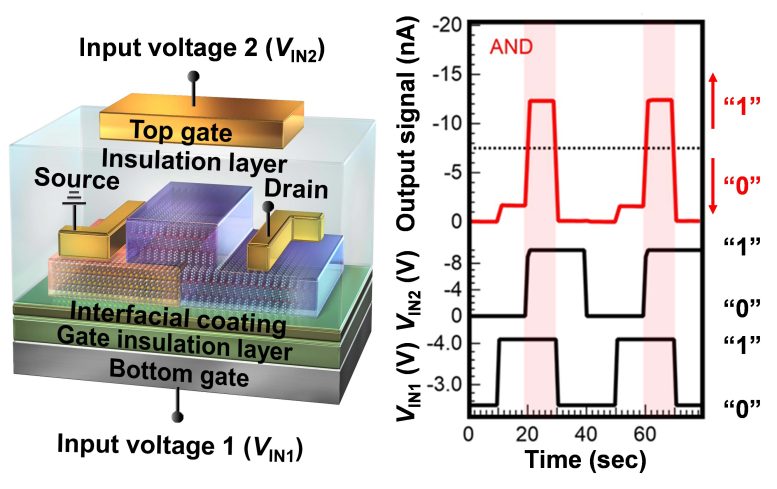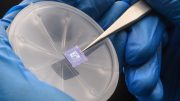
A new organic anti-ambipolar transistor has been developed that is capable of performing any one of the five logic gate operations by adjusting the input voltages to its dual gates. It could be used to develop electrically reconfigurable logic circuits, which may be key to the development of high-performance mobile devices.
Construction of multiple logic circuits using only a single transistor.
The National Institute for Materials Science (NIMS) and the Tokyo University of Science have succeeded in developing an organic anti-ambipolar transistor capable of performing any one of the five logic gate operations (AND, OR, NAND, NOR, or XOR) by adjusting the input voltages to its dual gates. This lightweight transistor with multiple logic gate capability may be used to develop electrically reconfigurable logic circuits—potentially key to the development of high-performance mobile devices.
As the internet of things (IoT) becomes a reality, the volume of data that will need to be processed is expected to skyrocket. This will require lightweight, high-performance, mobile data processing devices. Organic integrated circuits with organic transistors are a potentially game-changing technology in the development of such devices. However, the integration density of these circuits has remained very low due to incompatibility with existing microfabrication technologies.
To address this issue, this research group developed an organic dual-gate anti-ambipolar transistor capable of performing two-input logic gate operations by designing it to reduce its drain current when the gate voltage exceeds a certain threshold.

Organic dual-gate anti-ambipolar transistor designed to perform an AND logic gate operation. Credit: Ryoma Hayakawa National Institute for Materials Science
When input voltages are applied to the top and bottom gates of the transistor, it produces an output signal (i.e., a drain current). This transistor demonstrated the ability to act as five different types of two-input logic gates at room temperature when the input voltages were adjusted. Existing integrated circuit technology requires four transistors to form a NAND circuit and 12 transistors to form an XOR circuit.
By contrast, only one of these newly developed transistors is needed to form these circuits. In addition, this transistor may be used to substantially increase the integration density of organic circuits, which has been a major challenge in organic electronics. In future research, the group plans to develop electrically reconfigurable integrated circuits using this new transistor.
Reference: “Electrically Reconfigurable Organic Logic Gates: A Promising Perspective on a Dual-Gate Antiambipolar Transistor” by Ryoma Hayakawa, Kosuke Honma, Shu Nakaharai, Kaname Kanai and Yutaka Wakayama, 10 February 2022, Advanced Materials.
DOI: 10.1002/adma.202109491
This project was carried out by Ryoma Hayakawa (Senior Researcher, Quantum Device Engineering Group (QDEG), International Center for Materials Nanoarchitectonics (MANA), NIMS), Shu Nakaharai (Principal Researcher, QDEG, MANA, NIMS), Yutaka Wakayama (Leader of QDEG, MANA, NIMS), Kosuke Honma (graduate student, Tokyo University of Science) and Kaname Kanai (Professor, Tokyo University of Science). This work was conducted under the NIMS–Tokyo University of Science Joint Graduate School framework in conjunction with another project entitled “Development of an organic negative resistance transistor in an effort to significantly increase the integration density of organic circuits” (principal investigator: Yutaka Wakayama, project number: 19H00866) funded by the JSPS Grant-in-Aid for Scientific Research (A).









Be the first to comment on "New Organic Transistor Enables Higher Density Circuit Integration for High-Performance Mobile Devices"